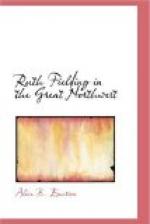Wonota in her Indian canoe—a carefully selected one and decorated in Indian fashion—was embarked on the sullen stream above the timber-boom. The holding back of the water and the driftwood had formed an angry stretch of river which under ordinary circumstances Ruth and the other girls who had accompanied her West thought they would have feared to venture upon. The Indian girl, however, seemed to consider the circumstances not at all threatening.
With her on the river, but instructed to keep on either side and well out of the focus of the cameras, were two expert rivermen, each in a canoe. These men were on the alert to assist Wonota if, when the dam was broken, she should get into any difficulty.
Below the dam the men were arranged at important points, so that if the logs and drift threatened to pile up after the boom was cut, they could jump in with their pike-poles and keep the drift moving. On one shore the cameras were placed, and Jim Hooley, with his megaphone, stood on a prominent rock.
Across from the director’s station Ruth found a spot at the foot of a sheer bank to the brow of which a great pile of logs had been rolled, ready for the real freshet in the spring when the log-drives would start. She had a good view of all that went on across the river, and up the stream.
Jennie suggested that she and Helen accompany Ruth and watch the taking of the picture from that vantage point, a proposal to which Helen readily agreed. But Ruth evaded this suggestion of her two friends, for she wanted to keep her whole mind on her work, and when Helen and Jennie were with her she found it impossible to keep from listening to their merry chatter, nor could she keep herself from being drawn into it. The upshot was that, after some discussion by the three girls, Ruth set off alone for her station under the brow of the steep river bank.
About ten o’clock, in mid-forenoon, Hooley was satisfied that everything was ready to shoot the picture. One of the foremen of Benbow Camp—the best ax wielder of the crew—ran out on the boom to a point near the middle of the frothing stream and began cutting the key-log. It was a ticklish piece of work; but these timbermen were used to such jobs.
The gash in the log showed wider and wider. Where Ruth stood she cocked her head to listen to the strokes of the axman. It seemed to her that there was a particularly strange echo, flattened but keen, as though reverberating from the bank of the river high above her head.
“Now, what can that be?” she thought, and once looked up the slope to the heap of logs which were held in place by chocks on the very verge of the steep descent.
If those logs should break away, Ruth realized that she was right in the path of their descent. It would not be easy for her to escape, dry-footed, In either direction, for the bank of the river, both up, and down stream, was rough.
But, of course, that chopping sound was made by the man cutting the boom. Surely nobody was using an ax up there on the pile of logs. She glanced back to the man teetering on the boom log. The gap in it was wide and white. He had cut on the down-river side. Already the pressure from up stream was forcing the gash open, wider and wider——




